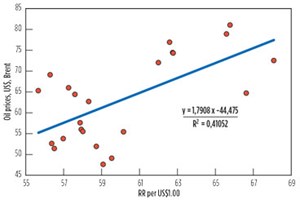Oil and gas in the capitals
Over the last two years, Russia’s policy toward oil prices has been closely associated with a willingness to achieve an understanding with the OPEC countries. Hence, Russia has developed close contacts, and some agreements, with Saudi Arabia. This situation surprises more than a few, when the Russian and Saudi positions on the Syrian conflict are considered.
But this is not the only astounding development. The ruble exchange rate has been associated with oil prices for quite a long time. When oil prices were rising, the ruble strengthened. When oil prices fell, the ruble depreciated heavily. Yet, this situation seems to be changing. And that opens new opportunities for the Russian government.
For the Russian population, the ruble exchange rate is as much a social as economic factor. More importantly, the exchange rate is also perceived as an indicator of social stability. The relation then, between oil prices (usually expressed in Brent prices) and the exchange rate, has been of paramount importance. This relation seemed quite well-established during the last nine years.
A recent difference. But, since 2016, something has been changing. The Central Bank policy has focused much more on inflation than on the exchange rate. This helped Russia to avoid a massive financial problem, when oil prices collapsed from late 2014 to early 2016. The exchange rate quickly adjusted to oil market conditions. Producer costs are mostly ruble-denominated, but their revenues are partly dollar-denominated, so the health of the oil (and gas) sector improved. This helped Russia to muddle through an adverse environment, not just because of oil prices but also U.S. and European sanctions. By early 2017, with oil prices rising, the ruble should have appreciated. It did, but not as much as expected.

Indeed, the relation between oil prices and the exchange rate has changed considerably. Oil prices rose (from $50 to $80), but the exchange rate, after some appreciation, stabilized and even declined. This trend has been examined, Fig. 1.
Actually, taking oil price into account, Russia’s economic and financial situation changed. Due to massive efforts to boost non-oil activities, Russia’s economic structure began to evolve. This was the unexpected result of Western sanctions. It seems that the old target of “economic diversification” became a true imperative in the new geopolitical context. While oil and gas, and commodities generally, are still important to Russia’s exports, the share of non-oil products has increased.
The low exchange rate made Russian goods competitive on export markets. In this situation, the current account balance will remain high, due to stable prices for Russian exported goods and will significantly exceed external debt repayments over the coming months. This is important for Russia’s financial stability.
In these conditions, the Bank of Russia’s decision to suspend foreign currency purchases in the domestic market will limit exchange rate volatility and its pass-through of inflation dynamics over the coming quarters. Quite clearly, maintaining an inflation rate under 4%/year is an important target that was exceeded in 2017 and early 2018, when inflation went down to an unprecedented (since 1991) rate of 2.7%.
What do these changes say about the future? The exchange rate will still be an important social and economic factor in Russia. But the new relation between oil prices and the exchange rate is easing pressure on the Russian government. It can allow oil prices to fluctuate without risking social and political capital. Another important point is that a low exchange rate (around 65-68 RR to $1.00) is important to maintain Russian goods’ competitiveness on foreign markets. The government and the Central Bank will certainly take measures to prevent a surge of the exchange rate, if oil prices go over $70/bbl. The current Central Bank toolbox is certainly enough until oil prices threaten to go over $85/bbl.
Thus, one can see why the Russian government, if it agrees on production cuts, is definitely not a driving force behind them. Russia would be quite happy to maintain prices in the $55–$80/bbl range, which seems achievable in the next few months. This would allow economic diversification to occur. But how would the Russian government react, if things got out of hand, and oil prices jumped to $100+? If some producers encountered serious political problems and saw their production levels falter, Russia has neither the capacity nor the power to equalize demand and supply. Then, the Russian path of development would be put to a severe test.
SAPIR@MSH-PARIS.FR / Jacques Sapir is a professor of economics at the School for Advanced Studies in the Social Sciences (EHESS) in Paris, and at the Higher School of Economics in Moscow. An expert on Russian economic policy, he graduated from the Institute of Political Studies in Paris in 1976, and earned a PhD in economics from EHESS in 1980. ![]()

- The last barrel (February 2024)
- Oil and gas in the Capitals (February 2024)
- What's new in production (February 2024)
- First oil (February 2024)
- E&P outside the U.S. maintains a disciplined pace (February 2024)
- Prices and governmental policies combine to stymie Canadian upstream growth (February 2024)


